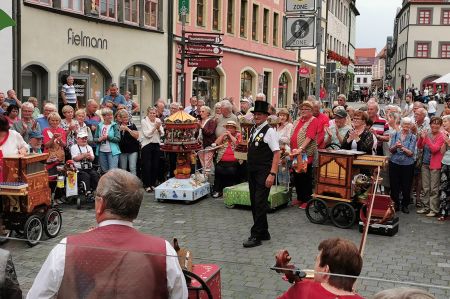Barrel organs and Laierkasten at Naumburg Wine Festival
- Written by Portal Editor
Who still knows them, the barrel organs, also known as barrel organs, which used to be pushed through many a city and then played in a busy location, much to the delight of many passers-by.
The players of this mechanical musical instrument barrel organ, popularly known as the barrel organ, operate a crank that sets a control system inside the instrument in motion, so that the organ pipes play the piece of music stored on an organ cylinder, on a piece of paper, on a folding box or in a midi file. Numerous readers can certainly still remember a single interpreter of this musical genre, now there was a real big meeting of numerous barrel organ players at the wine festival in Naumburg, first distributed at different locations, then gathering for two concerts.
Wine festival, barrel organ festival and pottery market in Naumburg
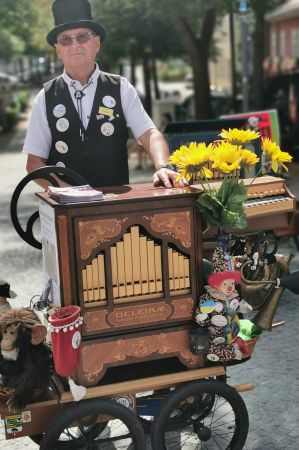 Naumburg always celebrates its wine festival on the last weekend in August, this year it took place from August 26th to 28th. As always, visitors were awaited by an extensive and diverse programme, not only for friends of fine wines. With the pottery market, the barrel organ festival and the wine culture, there is plenty of entertainment for young and old.
Naumburg always celebrates its wine festival on the last weekend in August, this year it took place from August 26th to 28th. As always, visitors were awaited by an extensive and diverse programme, not only for friends of fine wines. With the pottery market, the barrel organ festival and the wine culture, there is plenty of entertainment for young and old.
A fixture and indispensable are the barrel organ festival on Saturday, where barrel organ players from all over Germany liven up the city with their music. The festival opens at 10:30 a.m. on the Holzmarkt. The highlights are the concert in the St. Wenzel town church at 4:00 p.m. and the final concert at around 5:30 p.m. in front of the “Hohe Lilie” town museum. Afterwards you can enjoy Saale-Unstrut wine specialities, socializing and a colourful music and entertainment program there for the whole weekend.
A tradition from the 18th century - the barrel organ
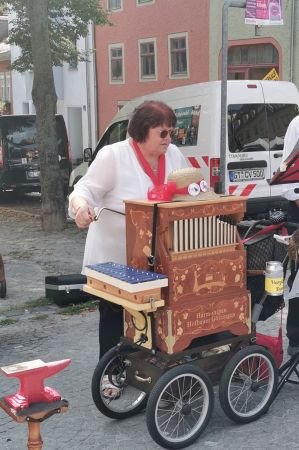 Since the beginning of the 18th century, the barrel organ has been known in all European countries as an instrument for street musicians and jugglers, but also - especially in England and France - as a church and salon instrument. Bänkelsänger also used a barrel organ. Many barrel organ players place a plush monkey on their instrument. This is meant to commemorate the time when itinerant musicians were often accompanied by a capuchin or rhesus monkey. The monkey was an additional attraction - especially for the children - and usually had the task of collecting coins from the bystanders.
Since the beginning of the 18th century, the barrel organ has been known in all European countries as an instrument for street musicians and jugglers, but also - especially in England and France - as a church and salon instrument. Bänkelsänger also used a barrel organ. Many barrel organ players place a plush monkey on their instrument. This is meant to commemorate the time when itinerant musicians were often accompanied by a capuchin or rhesus monkey. The monkey was an additional attraction - especially for the children - and usually had the task of collecting coins from the bystanders.
The barrel organs were initially built by organ workshops, but later factories emerged that only dealt with the "little sisters" of the church musical instrument.
There is a barrel organ tradition in many countries
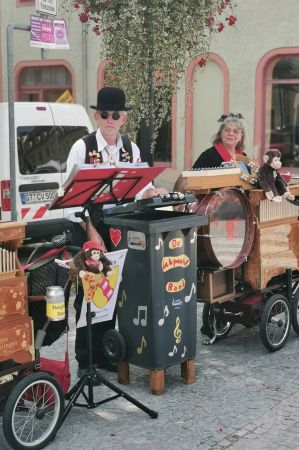 A variant of the barrel organ was the Greek lanterna, which was played by Yiftoi (Roma musicians) in the 19th century and up until the early 20th century. For accompaniment, the Yiftoi beat the frame drum with the daira tambourine. The solo entertainers with lanterna appeared on market squares, especially in the port cities of the Levant, sometimes accompanied by a wife or daughter who acted as a dancer, or they carried a dancing bear with them.
A variant of the barrel organ was the Greek lanterna, which was played by Yiftoi (Roma musicians) in the 19th century and up until the early 20th century. For accompaniment, the Yiftoi beat the frame drum with the daira tambourine. The solo entertainers with lanterna appeared on market squares, especially in the port cities of the Levant, sometimes accompanied by a wife or daughter who acted as a dancer, or they carried a dancing bear with them.
In France, the musical instrument is called the Orgue de Barbarie, which can be traced back to the first known manufacturer: the Italian Giovanni Barberi from Modena first demonstrated this small transportable organ in 1702.
Nowadays modern technology in barrel organs
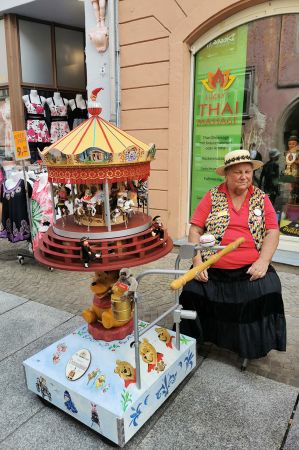 The structure of the barrel organ corresponds in principle to a stationary pipe organ. It consists of a case in which the pipework, the bellows, the windchest and the playing equipment are housed. With the help of a crank or a flywheel, the leather-covered bellows that generate the wind are actuated via a connecting rod.
The structure of the barrel organ corresponds in principle to a stationary pipe organ. It consists of a case in which the pipework, the bellows, the windchest and the playing equipment are housed. With the help of a crank or a flywheel, the leather-covered bellows that generate the wind are actuated via a connecting rod.
The wind is stored in a magazine bellows, calmed down and brought to a constant pressure with spring force. Hydroelectric power was also occasionally used to operate larger barrel organs (e.g. Hellbrunn Palace, Villa d'Este and Wilhelmshöhe water organ).
The pipework stands above the windchest, which contains a large number of valves. A tone (a whistle or several whistle of different types) is assigned to each valve. The number of tones can be different for barrel organs. These valves are controlled by the gaming device.
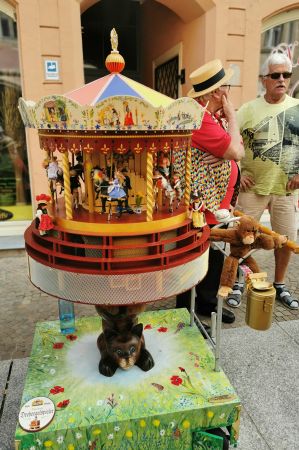 This can be done pneumatically, mechanically or electromagnetically. The pipes are similar to those of a church organ; Normally, either exclusively labial whistles or only reed whistles are used, since the entire pipework does not get too out of tune with the usual open-air playing.
This can be done pneumatically, mechanically or electromagnetically. The pipes are similar to those of a church organ; Normally, either exclusively labial whistles or only reed whistles are used, since the entire pipework does not get too out of tune with the usual open-air playing.
In contrast to an organ that can be played manually, a program carrier takes over the control of the tones, which is located in the playing device. The oldest form of the program carrier is the pin roller, which has been known since antiquity. A pinned roller (usually interchangeable) can contain up to twelve pieces of music (six to eight are common). The running length of the piece of music is limited by the circumference of the rollers.
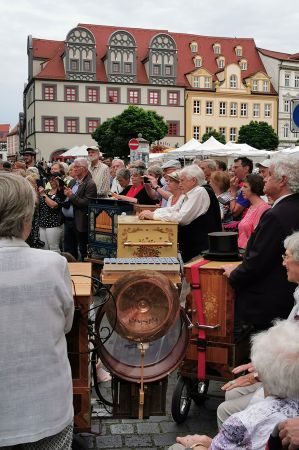 At the beginning of the 20th century, the punched tape and the punched card replaced the pin roller. Electronic controls, commonly known as microchips, have become more common since the early 1980s.
At the beginning of the 20th century, the punched tape and the punched card replaced the pin roller. Electronic controls, commonly known as microchips, have become more common since the early 1980s.
The pieces of music are stored in proprietary formats, most recently as midi files on memory cards. With punched tapes or punched cards (both interchangeable) and electronic controls, the playing time is almost unlimited.
The rotary movement of the crank also moves the program carrier in the case of mechanical or pneumatic control.
State of the art for electronic controls is controlling the playback speed of the piece of music by changing the speed of rotation of the crank.
Musical ability prerequisite in dubbing
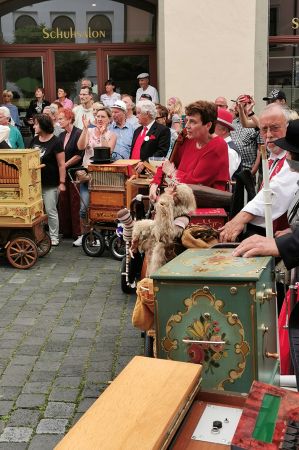 Simpler electronic controls lack this possibility - the playback speed is always the same, regardless of whether the crank is moved slowly or quickly. Electronically controlled barrel organs can even be synchronized via radio or cable. All organs either play the same notes of the piece of music, or they take over individual parts of a kind of orchestral score, as was partly shown in Naumburg. The art of the arranger or programmer decides on this. The playback does not actually require any musical ability on the part of the organ builder. On the other hand, synchronous playing with two or more perforated tape-controlled barrel organs of the same type requires practice and skill coupled with musicality and a sense of rhythm, and some barrel organs are also equipped with additional rhythm instruments.
Simpler electronic controls lack this possibility - the playback speed is always the same, regardless of whether the crank is moved slowly or quickly. Electronically controlled barrel organs can even be synchronized via radio or cable. All organs either play the same notes of the piece of music, or they take over individual parts of a kind of orchestral score, as was partly shown in Naumburg. The art of the arranger or programmer decides on this. The playback does not actually require any musical ability on the part of the organ builder. On the other hand, synchronous playing with two or more perforated tape-controlled barrel organs of the same type requires practice and skill coupled with musicality and a sense of rhythm, and some barrel organs are also equipped with additional rhythm instruments.
When 20 or more-barrel organs come together, as was the case in Naumburg, a coordinator who really knows his trade is needed. The crowd of people who had gathered around the barrel organs in a circle for these two concerts was amazing and musically of the highest quality, a special experience.
Please read well:
Bike tour to Kallmünz - Camping Pielenhofen at Naab river
Salamis on Cyprus - ancient town kingdom near Famagusta
-
 Barrel Organ Festival in Naumburg
Barrel Organ Festival in Naumburg
Barrel Organ Festival in Naumburg
Barrel Organ Festival in Naumburg
-
 Barrel Organ Festival in Naumburg
Barrel Organ Festival in Naumburg
Barrel Organ Festival in Naumburg
Barrel Organ Festival in Naumburg
-
 Barrel Organ Festival in Naumburg
Barrel Organ Festival in Naumburg
Barrel Organ Festival in Naumburg
Barrel Organ Festival in Naumburg
-
 Barrel Organ Festival in Naumburg
Barrel Organ Festival in Naumburg
Barrel Organ Festival in Naumburg
Barrel Organ Festival in Naumburg
-
 Barrel Organ Festival in Naumburg
Barrel Organ Festival in Naumburg
Barrel Organ Festival in Naumburg
Barrel Organ Festival in Naumburg
-
 Barrel Organ Festival in Naumburg
Barrel Organ Festival in Naumburg
Barrel Organ Festival in Naumburg
Barrel Organ Festival in Naumburg
-
 Barrel Organ Festival in Naumburg
Barrel Organ Festival in Naumburg
Barrel Organ Festival in Naumburg
Barrel Organ Festival in Naumburg
-
 Barrel Organ Festival in Naumburg
Barrel Organ Festival in Naumburg
Barrel Organ Festival in Naumburg
Barrel Organ Festival in Naumburg
-
 Barrel Organ Festival in Naumburg
Barrel Organ Festival in Naumburg
Barrel Organ Festival in Naumburg
Barrel Organ Festival in Naumburg
-
 Barrel Organ Festival in Naumburg
Barrel Organ Festival in Naumburg
Barrel Organ Festival in Naumburg
Barrel Organ Festival in Naumburg
-
 Barrel Organ Festival in Naumburg
Barrel Organ Festival in Naumburg
Barrel Organ Festival in Naumburg
Barrel Organ Festival in Naumburg
-
 Barrel Organ Festival in Naumburg
Barrel Organ Festival in Naumburg
Barrel Organ Festival in Naumburg
Barrel Organ Festival in Naumburg
https://www.alaturka.info/en/germany/saxony-anhalt/6256-barrel-organs-and-laierkasten-at-naumburg-wine-festival#sigProIdab8cee0794
